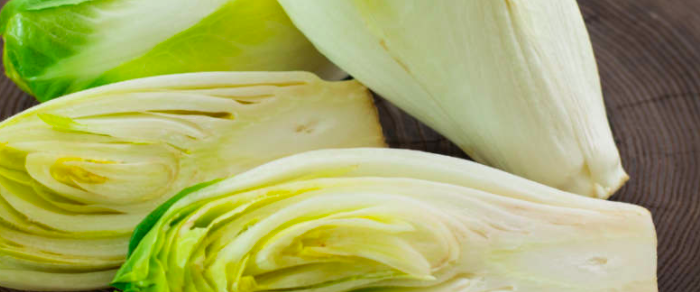
Endive is a variety of bitter chicory that can be eaten both raw and cooked. Light and digestible, it combines crunch and bitterness. It is typical of the North of France, which is the first European producer, and results from a sharp know-how.
Endive characteristics:
- Rich in fiber;
- Source of vitamin B9;
- Source of vitamin C;
- Source of potassium;
- Fight against constipation;
- Power of “appetite suppressant”.
What is endive?
Endive identity card
- Type: Chicory;
- Season: October to April;
- Family: Asteraceae;
- Origin: Belgium;
- Color: White for the most common;
- Flavor: Bitter and fresh.
Endive characteristics
The most common endive is made up of white leaves with yellow edges. The leaves are light and crisp.
Differences with nearby foods
Endive is a close cousin of salads, but we would rather group it with salads with a bitter flavor such as escarole or curly.
Word from the nutritionist
To make the most of the benefits of endive, it must be eaten raw.
To remove bitterness during cooking, remove the small white cone at the base of the core.
Nutritional values
For 100g of raw endive:
| Nutrients | Quantities |
| Protein | 1.1 g |
| Fat | 0.2g |
| Carbohydrates | 3.15 g |
| Water | 90g |
| Fibers | 1 g |
| Vitamin C | 1.5 mg |
| Vitamin B3 | 0.13 mg |
| Calcium | 23.9 mg |
| Potassium | 183 mg |
| Zinc | 0.19 mg |
| Iron | 0.14 mg |
7 benefits of endive: why eat it?
- Rich in water, endive helps cover daily water needs.
- Low in calories, it can be consumed during periods of weight loss.
- Its high fiber content allows it to fight against constipation by stimulating intestinal transit.
- It is given the power of natural “appetite suppressant”. Thanks to the water and the fibers it contains, the chicory will play on satiety and help regulate appetite.
- Rich in antioxidants, it protects cells against oxidative stress and protects the body from certain cancers.
- The vitamin B9 it contains is interesting for pregnant women for the good development of the nervous system of the fetus, and in growing children.
- Source of vitamin C, endive will also stimulate the immune system.
Choose your endive
To choose the endive well, it must be firm with very tight and very white leaves.
The different forms
The varieties we know all give white and compact endives. There is a cross between an endive and a red chicory which gives a variegated variety of purple.
Keep well
The endives can be stored up to 6 days in the vegetable drawer of the refrigerator, by wrapping them in absorbent paper.
They must be sheltered from light because in its presence, they risk turning green and developing their bitterness.
Endive preparation
How to cook endives? Endives with ham, endive salad and many others
The endive is eaten both raw and cooked.
Here are some ideas for cooking it:
- In a salad with nuts, cheese, apple;
- As trays for the aperitif, garnish the leaves with tuna rillettes or cheese;
- Braised in a pan with a little brown sugar or orange juice;
- In gratin, previously cooked in water, then rolled with ham, béchamel and grated Gruyère cheese;
- In velouté with a little cream;
- Simply steamed with white meat or fish.
History of endive
Endive is a recent vegetable. Its culture was not developed until 1850 by the head gardener of the Belgian Horticultural Society, a certain Mr. Bréziers. At the time, there was only the variety of chicory witloof. She arrived in Paris only 30 years later and the legend tells that it would be a town crier, not really knowing the name of this vegetable, which would have called it “endive de Bruxelles”, which will then be transformed into simple “endive “.
Over the years, plans have been selected to create new varieties less bitter.
Current cultivation methods allow endives all year round.
For further
Endive culture
The culture of endive takes place in three main stages: the production of the roots, the forcing that is to say the growth of the endive itself and the final harvest called “breaking”.
To obtain beautiful endives, it is important to cultivate them in a deep soil, without stone and well loosened, associated with a regular watering and weeding.